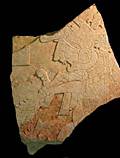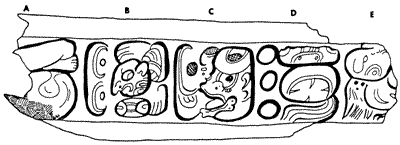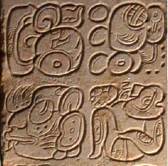
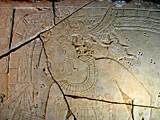
| 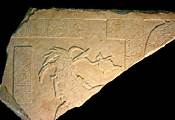
|
Background information on the find
Additional photographs and readings
By Joel Skidmore
|
On October 10, 2002, Palenque site director Juan Antonio Ferrer announced a new discovery from just south of the Cross Group (see map). A stone tablet with an elaborate scene and numerous hieroglyphs carved in relief was found on the side of a low platform in Temple XXI. It now joins the canon of historically vital and stunningly beautiful monuments from this Classic Maya site in Chiapas, Mexico.
The discovery was actually made on August 27 of this year by archaeologists of Mexico's National Institute of Anthropology and History (INAH) while working on the restoration of Temple XXI. The monument is quite similar to the stone platform found in nearby Temple XIX by Alfonso Morales and the Group of the Cross Project in 1999. The Temple XIX monument has been variously described as an altar, a throne, a bench and a platform. Accordingly, the first newspaper report on the latest find, in La Republica en Chiapas, calls the new monument a throne-altar-platform. |
|
K'inich Ahkal Mo' Nahb' III himself is the left-side figure in the sculptured relief. A caption for the central figure, seated on a jaguar-skin covered throne, states that he is impersonating a deity (or deified ancestor) whose name ends in U "K'ix" Chan. This name appears in Palenque's royal genealogy with a supposed time of rulership dating to the Olmec era (he is said to have been born in 993 BC).
The first part of the name — or the name of a different deity/ancestor altogether — is the same as that of the Palenque ruler known by the nickname Casper, who acceded in AD 435 and ruled for fifty-two years. The "Casper" glyph also appears in the main text, associated with a Palenque emblem glyph as if he were a historical king. But David Stuart points out that he is stated to have supervised an event several hundred years BC, so he can't be the Casper from the previously known dynastic sequence (nor does this date overlap with U "K'ix" Chan). The figure impersonating this character or characters is named as a Five K'atun Ajaw, meaning that he lived to be at least eighty years old (in Maya reckoning, seventy-nine in ours). This is none other than the famous king of Palenque, Pakal the Great. See the background information on the find. Temple XXI is located just south of the Cross Group. Archaeologist Arnoldo González Cruz and an INAH team have been working on its restoration since the beginning of the year, mitigating the effects of a collapsed roof. González Cruz is known for his discovery of the "Red Queen". The following information was received via email from Palenque: "The bench or throne with inscriptions is in the southeast gallery of Temple XXI. The bench spans the 3 meter gallery joining a medial pier with the south wall and the glyphs grace the front edge of the slab. This slab, which measures aproximately 3 meters by 1.70 meters, shows signs of breakage and stacking of the fragments on the south side (possibly Precolumbian looting). The rubble from the roof that collapsed onto it caused further damage. "Directly in front of it was a beautiful tablet measuring almost 3 meters by 55 cm. This tablet was damaged the most on the left-hand side by an immense vaultstone that landed on it, shattering and hurling pieces of it as far as three meters. Despite the damage they have been able to recover so far at least 90%. Framing the tablet is a text similar to the Temple XIX tablet on the south side of the throne. They are still piecing together the first part of the text, but the right-hand side is intact except for a couple of glyphs. "The Image begins on both the right hand and left hand with two rodent-like were-jaguars in the capes of a jaguar skin whose head drags down behind like a tail. Their hands and feet are those of jaguars, and they extend a bouquet or bunch of feathers and tassles toward three other more human looking fellows in royal dress and headress that kneel before them. Facing the jaguar figures are two figures in feather capes (possibly the same capes as the feather bunches that the jaguars hold out). "The third figure is the central one, and without a doubt the most important. He holds in his right hand the personified bloodletter and seems to hand it toward an unreceptive Ahkal Mo' Nahb'. (It is strange that both the other figures turn away from him. Perhaps the answer is in the depth of field, as these two figures' knees hide behind the throne backing. They are clearly behind the central figure. He may be handing the object to someone else outside of the picture.)" October 14, 2002 An article in the newspaper La Jornada, datelined October 11, identifies the figure seated to Pakal's left on the new monument as the elder son of K'inich Ahkal Mo' Nahb' III, whose existence was first made known to the world by the discoveries in Temple XIX. Identified there by his pre-regnal name, Upakal K'inich, he would go on to rule as K'inich Janahb' Pakal II. (See A New Palenque Ruler.) The newspaper article does not say if Upakal K'inich is named in the glyphic caption adjacent to his image, but he is said to appear somewhere in the text under the designation b'aah ch'ok ("head prince" or "heir to the throne"). This information is attributed to epigrapher Guillermo Bernal Romero, who is aware that Upakal K'inich is called b'aah ch'ok on the beautiful stucco panel from Temple XIX. Apparently Upakal K'inich is also named in glyphs on the edge of the lid that covers the new Temple XXI platform. Another exciting piece of information is that the main inscription also mentions the mother of K'inich Ahkal Mo' Nahb' III. Depicted on the right side of the Tablet of the Slaves, this woman's prominence in the text of the Temple XVIII Jambs once led to speculation that she was the conduit of her son's royal legitimacy. This was before it was known that her husband was a son of Pakal. As it turns out, K'inich Ahkal Mo' Nahb' had no cause to claim legitimacy through his mother (see background information on the find). Why then these conspicuous references of the woman whose name-glyph can be translated as Ix ("Lady") Kinuuw? The answer may lie in the fact that, according to the newspaper report, she is said to come from a place called Ux Te' K'uh. A polity by this name is known from glyphic history as the victim of a war waged by Tortuguero. It first appears in the inscriptions of Palenque in a statement on the north sanctuary jamb panel of the Temple of the Sun naming the grandfather of K'inich Kan B'ahlam (Pakal's oldest son). This individual's name phrase ends in "He of Ux Te' K'uh". According to David Stuart (in prep.), this same historical figure may be named in the text on the west side of the Temple XIX platform. And the central figure depicted thereon (a different individual from the one named in the main text) is captioned "He of Ux Te' K'uh". Perhaps Palenque cemented its long-time relationship with Ux Te' K'uh by intermarriage and celebrated this fact by the prominence accorded to the mother of K'inich Ahkal Mo' Nahb' III and to the enthroned figure facing west on the platform in Temple XIX. October 25, 2002
Information was received today regarding the hieroglyphic text that runs along the edge of the lid covering the platform or throne in Temple XXI. It turns out that a piece of this inscription (pictured above) has been known ever since Linda Schele and Peter Mathews catalogued Palenque's archaeological storeroom in the 1970's (Schele and Mathews 1979: no. 489). The fragment above is discussed in David Stuart's "Ritual And History in the Stucco Inscription from Temple XIX at Palenque" (online at PARI). The glyph at E is a sign associated with a particular calendric interval that is recorded in Temple XIX, so this is another tie between that structure and Temple XXI. Interestingly, Stuart describes it as a "fragment of a stone slab, possibly a throne or sarcophagus lid". Glyph D in the drawing above is part of the date 9.13.17.9.0 3 Ajaw 3 Yaxk'in, on which the son of K'inich Ahkal Mo' Nahb', the future K'inich Janahb' Pakal II, took part in a ritual. The rim text is said to mention K'inich K'an Joy Chitam II, who was king on this date, two years before his capture by Tonina. (Other relevant dates.) It was also confirmed today that the reference to the mother of K'inich Ahkal Mo' Nahb' III is in the left-hand portion of the main text gracing the side of Temple XXI's platform or throne. October 29, 2002
The drawing just above, showing the location of the discovery in Temple XXI, is based on an illustration in Lakamha', an informational bulletin of the Museum and Archaeological Zone of Palenque published by Conaculta-INAH. "B" marks the location of the platform or throne in the southeast corner of the structure, extending from a medial pier to the wall. "A" indicates where the sculptured tablet, which once graced the west side of the throne, was found. Please note that Temple XXI actually faces northeast by north, because it was angled to face the Temple of the Cross (see map). Lakamha' (Special No. 1) contains an article entitled "Discoveries in Temple XXI, Palenque, 2002 Season" by Arnoldo González Cruz, Guillermo Bernal Romero, Miguel Ángel Vazquez del Mercado Rodriguez, and Yalo Madrigal Cossio. The bulletin is undated but was published before the formal announcement of the discovery on October 10 of this year. The article begins by establishing that archaeological explorations just to the south of the Cross Group Plaza, principally in Temples XXI and XXII, were carried out during 2002 by the Palenque Archaeological Project directed by archaeologist Arnoldo González Cruz, investigator for the Chiapas INAH Center, and financed by PEMEX, the Governor of the State of Chiapas, and the National Institute of Anthropology and History (INAH). It was on August 27, 2002, in the course of liberating the southeast corner of the building that a masonry throne covered by a limestone laja or slab was encountered. Along one side of the slab was a hieroglyphic inscription. This find was the harbinger of a still more important discovery to come. In September, upon removing the rubble from the building collapse which covered the area in front of the throne, a large tablet was exposed to view. Its sculptured side was facing the floor. The monument originally decorated the west side of the throne. (It is appropriate to refer to the throne itself as a monument, since the tablet once adhered to it.) The tablet was broken into multiple fragments, but owing to the great care taken by the archaeologists and restorers some 95 percent of the sculpture was recovered. The fragments were taken to the restoration laboratory in the archaeological zone, where (at the time of writing) specialists were working to restore it to its original condition. It is a tablet of large dimensions, approximately 2.2 meters long by 70 cm tall. Due to the fact that the restoration was still in process, the authors limited themselves to a preliminary description of the best-conserved sections of the scene and the glyphic text. Of the three central figures, they identified the one on the left as Ahkal Mo' Nahb' III, referring to him as the ruler who commissioned the tablet and constructed Temple XXI in the year AD 736. One novel piece of information revealed by their analysis is that the childhood name of this ruler is said to have been Okib'. (Interestingly, this name or title occurs in the glyphic caption on the north sanctuary jamb panel of the Temple of the Sun, pointed to by David Stuart [in prep.] in connection with a historical figure apparently referred to in the texts of Temple XIX. The photographs in Merle Greene Robertson's Sculpture of Palenque, [Vol. IV, pp. 117-18] show a name and title string that may be transliterated Yax Itzam Aat Tuun Ajaw Okib' Aj Ux Te' K'uh.) The writers indentify the central figure as K'inich Janahb' Pakal, "The Great", the illustrious ruler who died a half century before the tablet was carved. They note that Ahkal Mo' Nahb' is represented as his companion, as if he were alive, because Pakal was a historical figure endowed with great prestige. According to their reading of the glyphs, the caption text associated with Pakal indicates that he was the incarnation or "image" of a legendary ruler of Palenque who was called Ch'away Chaak U Kix Kan. (Ch'away is Guillermo Bernal's reading of the "Casper" glyph.) By their calculations, the principal text indicates that Ch'away Chaak was a lord of Palenque in the year 252 BC. (David Stuart has also arrived at this date.) Passing to the right side of the scene, they observe another dignitary identified glyphically as Chaak Pakal K'inich, of whom it is said that he was "principal heir to be lord of Palenque". They connect this name to that of the son and successor of Ahkal Mo' Nahb' who elsewhere is called U Pakal K'inich. According to the article, the main glyphic text offers interesting data about the parents of Ahkal Mo' Nahb' III. Unexpectedly, it affirms that his mother, Lady Kinuuw Mat, was originally from a site called Ux Te' K'uh, located on the periphery of Palenque, perhaps on the Tabasco Plain. The authors point to an inscription from Tortuguero, Tabasco, indicating that the local king B'alam Ajaw attacked the city of Ux Te' K'uh (which they refer to as Aj Ox Te' K'uh) in the year 649. From this they deduce that the family ruling Ux Te' K'uh was assimilated into the Palenque dynasty and with the passage of time assumed power. They note that on the west tablet of Temple XIX, Ahkal Mo' Nahb' III seems to be accompanied by a dignitary named Sajal B'olon, who also came from Ux Te' K'uh. With the cautionary remark that the left block of the glyphic inscription suffered severe damage when the building collapsed, as two big pieces of the roof fell onto this section of the floor, the authors submit that it is possible to reconstruct dates and deduce the basic character of the inscription. They offer this summary of the events of the inscription as a whole: A) 9.15.2.7.16, 9 Kib, 19 K'ayab, 10 January 734. Reconstructed date, unknown event. (Note: the 9.15.2.07.16, 9 Kib, 19 K'ayab event is actually the dedication of Temple XIX. And the 9.15.4.15.17, 6 Kaban, 5 Yaxk'in event involving GII and GIII is recorded on the west side of the platform in Temple XIX.) A very important appendix to the article concerns the recovery in Temple XXI of additional fragments from Temple XVII (which the authors refer to as the Temple of the Warriors). It seems that fragments of the Temple XVII Panel were found as fill in the walls on the west side of Temple XXI. The main portion of this tablet was excavated in 1993 and is currently on exhibit in the Alberto Ruz Lhuillier Site Museum. The excavations in Temple XXI have not yet ended, and the archaeologists hope to discover more fragments of this noteworthy sculpture and its inscription. In the meanwhile, they have distributed the following preliminary reconstruction and reading to the press: |
Photo of Temple XVII fragments and preliminary reading.
| The archaeologists and INAH have also made available a photograph and a preliminary reading of some of the glyphs from the Temple XXI throne. The main glyphic text of the tablet is composed of columns A-D on the left side of the scene and E-H on the right. The photograph shows glyphs E1-F10. (The detail which appears just below shows glyphs E9-F10.) The preliminary glyphic reading is by Guillermo Bernal Romero. |
|
|
| home | top |
October 17, 2003
|
A presentation about the Temple XXI monument discovered in August, 2002, was given by archaeologist Arnoldo González Cruz last Tuesday at the Regional Museum in Tuxtla Gutierrez, as reported by China Daily.
This caused some to imagine that yet another "1,200 year-old stone slab with carvings" had been unearthed at Palenque. But in fact the China Daily article was quite clear in stating that the find was not recent. |
| According to the China Daily report, the carving depicts five figures including the renowned Palenque ruler Pakal. The latter is said to be "offering a weapon issued for self-sacrifice to his grandchild who has his back turned and is speaking with a supernatural rodent figure that's wearing a coat made of jaguar skin." Comparison with the photograph above (Pakal is on the right) makes it clear that the carving being referred to is the monument discovered by González Cruz and his INAH team in 2002. |
home - top
